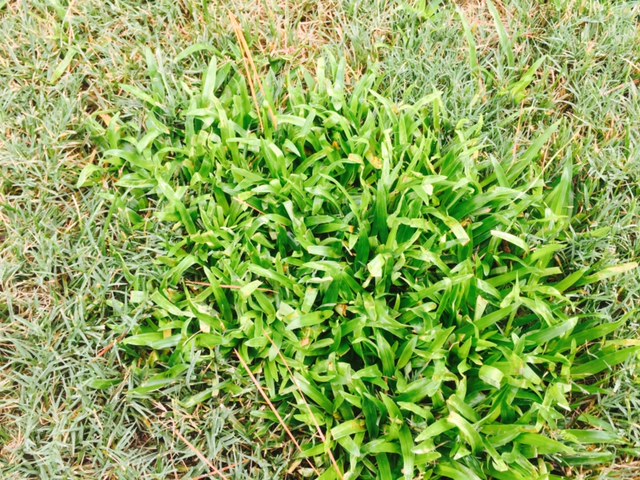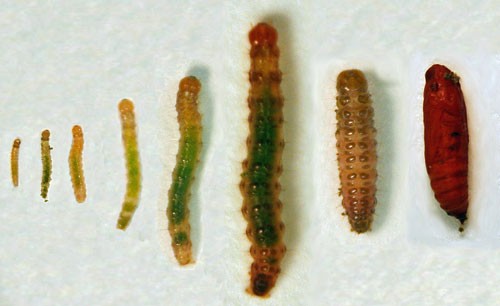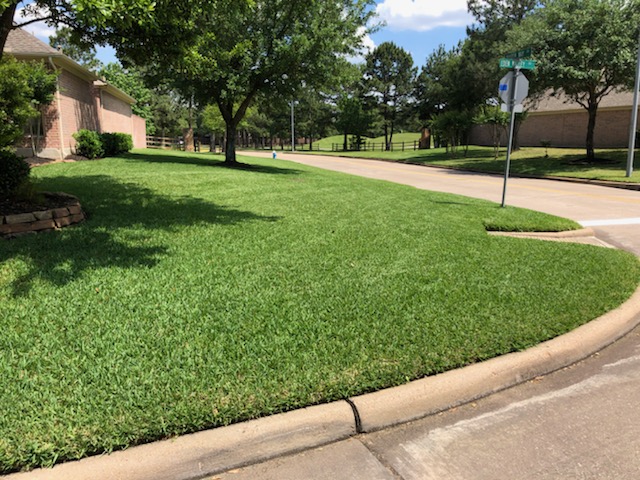Last weeks rain saw the return of one of the most destructive weed to lawns.
We all know I can be a little bit excitable about grass and its various enemies but I don’t think I exaggerate in warning you immediately of this weeds come back. Let me try to control my inner grass geek to give you the need to know on this lawn endangering weed.
What Is Doveweed?
Doveweed is a grassy looking, fast-spreading summer annual weed.
- It strongly resembles grass from a distance.
- It thrives in hot, humid conditions.
- It spreads by leaf clippings alone.
- It is easily capable of taking over any Houston lawn.
- It first appears in May and dies off in November/December when temperatures drop.
- It produces a purple flower in mid to late fall.
What and where to look for.
- Look in low spots, bare areas or anywhere you know you had it last year.
- When in its initial form it looks like tiny grass blades.

- Once fully emerged Doveweed grows with 3 blades.

- It spreads rapidly. I cannot understate this, Doveweed grows and spreads obviously within a 24 hour period. It can cover 100s of sqft within a week in the right conditions.

Best Prevention Practices.
In a year when fungal problems have become a local epidemic minimizing the use of chemical herbicides has never been more important: Prevention is the best treatment.
We recommend the following practices to prevent Doveweed.
- All mowing equipment should be cleaned prior to every use. If your lawn crew will not do this provide your own equipment.
- Minimize edging as much as possible, nothing spreads Doveweed faster than a weed eater!
- Bag clippings.
- Only water when necessary (please see our regular Newsletters for watering information)
- Customize your sprinkler zones and times to avoid overwatering low spots.
- Add sand or soil to low areas.
- Add sod (or seed if applicable) to bare areas.
Treatments.
There are a few different solutions for Doveweed not one of which is right for every lawn.
As mentioned above chemical herbicide can easily aggravate fungal problems so carefully access the condition of your lawn before choosing your treatment. If you are at all unsure then consult with a lawn care expert.
- Chemical herbicide. In my experience Blindside is the most effective but is also more likely to cause damage or aggravate fungus than my other suggested herbicide, Celsius.
- Crabgrass Killer this is an organic weedkiller. Unfortunately it can be time and cost-intensive but it is very effective and will not aggravate fungus. It is available locally at Plants For All Seasons.
- Hand pulling. Ideally, you would hand pull the weed from the root, you need to remove every part of it and ceremoniously burn it!
- Apply sand or soil to areas affected after any of the above treatments.
Doveweed is pre-emergent resistant. Although we have found it can be effective as a part of an overall treatment plan we have recently discovered regular application of pre-emergent can aggravate fungus and or contribute to under-developed root systems. We only suggest it in severe cases or if other organic methods are in place to promote good grass health.
Ultimately Mother Nature plays a huge role in determining how much of a problem Doveweed is and how effective treatments are. I strongly believe that following recommended practices is necessary to maintain any kind of control. The benefit of a healthy lawn is that is will fight its own battle, needing only assistance rather than an aggressive intervention.
The most important factor is to monitor your lawn. Catching this aggressive weed early is key.
If allowed to grow Doveweed will quickly become an expensive problem.
If you have questions about Doveweed in your lawn either give us a call at 281 940 9912 or email flahertylawns@gmail.com.





Leave A Comment